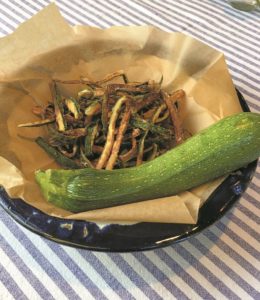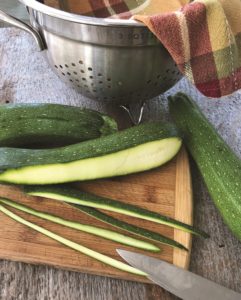It’s that time of year. Unlike some people, I don’t dodge neighbors heading my way with a basketful of zucchini. This beautiful, versatile vegetable can be sautéed, frittered, grilled, or stuffed, and contributes deliciously to savory tarts, frittatas, soup, bread, and salad. Considering all the ways there are to enjoy it, I found myself wondering if zucchini has always been around.
Like many familiar foods, zucchini is an international traveler. Domesticated millennia ago in Mesoamerica, various kinds of squash traveled to Europe with returning explorers. Centuries passed before green varieties were cultivated in Italy. Then in the 1920s, Italian immigrants brought zucchini here. Hence the Italian name, “little squash.”
I should have known. This sultry seaside air has had Hugo reminiscing about the platters full of fried zucchini that his Aunt Lil served up at a big table overlooking the ocean on the Jersey shore. It seemed effortless to prepare, and we should try it, Hugo said.

His aunt just set a large pasta pot on the stove, poured in some oil, and tossed in shoestrings of zucchini — “Aunt Lil always used small zucchini.” The way he remembered the scene, she herself always seemed smaller than the looming pot.
Aunt Lil did not need, or want, help in the kitchen, so Hugo enjoyed himself by eating more of this treat than anyone else in the family. She returned the compliment with, “God bless him, he’s eating.”
But trying to reconstruct his aunt’s magic proved elusive. As with many efforts at retrieving a flavor memory, Hugo’s first try was not a success — to be blunt, the fritti were soggy. We checked a hundred of Lil’s handwritten recipe cards, some in Italian, but found no trace of zucchini fritti.
Hugo emailed his brother Paul in Boston. Paul’s a doctor, but this was important, so he took a moment between seeing patients that morning to email back: “The trick is to get the water out. I think she would line a colander with paper towel or cheesecloth, put the strips in with salt and weight them down with something heavy.”
Hugo’s second try was better, texture-wise, though tasting more of salt than zucchini. So, he used less salt, rinsed and dried the vegetable strips, and our third try yielded tangles of crisp, delicately flavored zucchini. “That is the taste,” he said as we stood by the stove, picking up our fries as soon as we could without burning our fingers and devouring every last one.
I checked Joy of Cooking to see if there was an American version. But in my vintage edition the authors took a dim view of this all-round excellent vegetable — which provides a generous amount of vitamin C, also vitamin A, folate, and potassium, by the way. “Because squash is so bland in flavor,” they wrote, “it can stand a good deal of ‘doctoring.’ ”

Marcella Hazan set things straight in The Classic Italian Cookbook, praising zucchini as “one of the great favorites among Italian vegetables” with a very delicate taste “that is sometimes mistaken for blandness, which some try to cover up with seasonings.” I wondered if she had also checked Joy of Cooking. She advises that good zucchini are ideally about one-and-a-half inches in diameter and six inches long — small, just like Aunt Lil always said.
If you have medium-size zucchini, as we did, just pare away most of the white flesh and seeds after quartering them and before you slice the strips. But don’t discard these scraps — in our frugal kitchen we roast them with a couple of garlic cloves, olive oil, salt, pepper, and oregano for a succulent dip or sandwich filling.
Zucchini fritti can serve as an appetizer or garnish, perhaps, for a vegetable risotto or a grilled steak.
After we polished off the last of our fritti, we reflected on the quest to recapture long-ago flavors and memories. What makes success so elusive, to begin with, is that the faces around the table are different this time around. And the wonder of having a loved one make a childhood favorite for you might just be the missing spice.
“Maybe you can make them next time,” Hugo said, after he’d finished making the third batch and wiped the flour from the floor.
Aunt Lil’s Zucchini Fritti
Serves 2 as an appetizer
2 medium zucchini (about a pound)
Kosher salt
Canola or other neutral oil for frying
½ cup flour
Sea salt for sprinkling on top
Wash and quarter the zucchini lengthwise. Place them skin-side down and slice away most of the inner pulp and seeds (which can be saved for another use) — what you’re frying, really, are strips of skin with about a quarter inch of flesh on them. Then slice the zucchini quarters into narrow strips, about 1/8- to 1/4-inch wide.
Line the bottom of a colander with a cloth or paper towel and place the zucchini strips in the colander. Sprinkle with a tablespoon of salt and place a heavy bowl on top to press liquid from the strips. Thirty minutes to an hour should do it. Lightly rinse the zucchini, to remove salt, and blot it very dry.
Pour an inch of oil into a medium-size saucepan and heat until it shimmers.
Meanwhile, in a deep bowl, toss the zucchini with flour and shake off excess before dropping a test strip into the oil. It’s hot enough if the strip sizzles right away. Now pick up a good pinch of the zucchini strips with tongs or a large fork, and carefully, to avoid splattering, lower them into the hot oil. When they turn golden brown, in about 1-2 minutes, lift them from the pan and place them on paper towels to absorb any extra oil.
Continue, a few at a time, until all the strips have been fried and drained. Transfer the zucchini fritti to a warm plate and sprinkle to taste with salt — sea salt is really good for this.



